Road signs in Finland
Road signs in Finland are regulated in Tieliikenneasetus (5.3.1982/182).
Most signs are based on pictograms, except signs like the prohibition-sign for stop at customs and the sign indicating a taxi rank. If the sign includes text, the text is written in Finnish or Swedish, except the stop sign and taxi signs which are written in English (some taxi signs are written in Finnish). Many roads and places in Finland have Finnish and Swedish names, so both are marked on the traffic signs. This is common in the Swedish-speaking areas on the southern and western coasts, whereas in the inland Swedish names are far less common. In northern Lapland there are also traffic signs in the Sámi language.
At many unregulated intersections the practice is to yield to traffic on-coming from the right, unless there is a “yield” or "give way” sign posted for the right on-coming traffic. This can be a problem on some streets since these signs are not always visible to traffic that does not have to yield. Therefore, unless a driver is experienced with the area and its signs, they should take care to give way to the right at an intersection, even if the road he or she is on appears to be the priority road.
Finnish road signs depict people with realistic (as opposed to stylized) silhouettes.
Major differences between Finnish and general European signs
Whereas European signs usually have white background on warning and prohibition signs, Finnish signs have a yellow/orange colour. This is for the purpose of enhancing the visibility of the sign during the winter, as white signs would be hard to see in the snow. Prohibition signs displaying a symbol other than a numeric value have a diagonal red line across them. Prohibition signs in Slovenia and Sweden are similar in this respect. In most European countries, however, such signs do not usually include a red line.
Gallery
Warning signs
Warning signs are triangular, but in contrast to those of most other states using triangular warning signs, Finnish signs have yellow backgrounds, rather than white.
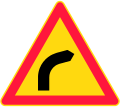 Dangerous curve to right
Dangerous curve to right Dangerous curve, bend to left
Dangerous curve, bend to left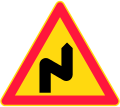 Dangerous curves, first bend to right
Dangerous curves, first bend to right Dangerous curves, first bend to left
Dangerous curves, first bend to left Steep hill downwards
Steep hill downwards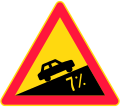 Steep hill upwards
Steep hill upwards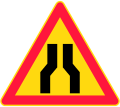 Road narrows on both sides
Road narrows on both sides Two-way traffic
Two-way traffic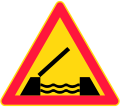 Opening or swing bridge
Opening or swing bridge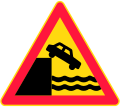 Quayside or ferry berth
Quayside or ferry berth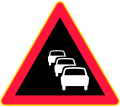 Queuing traffic
Queuing traffic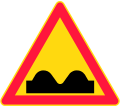 Uneven road ahead
Uneven road ahead Speed bumps
Speed bumps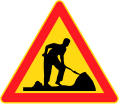 Road works
Road works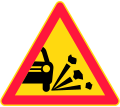 Loose chippings
Loose chippings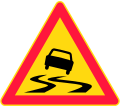 Slippery road
Slippery road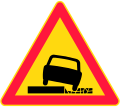 Dangerous shoulders
Dangerous shoulders Pedestrian crossing
Pedestrian crossing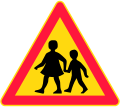 Children
Children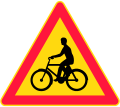 Cyclists and moped riders on carriageway
Cyclists and moped riders on carriageway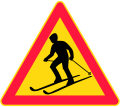 Skiers crossing
Skiers crossing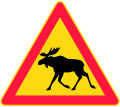 Animals (moose)
Animals (moose)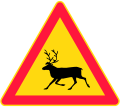 Animals (reindeer)
Animals (reindeer) Intersection with equal roads (give way to the vehicles coming from the right)
Intersection with equal roads (give way to the vehicles coming from the right)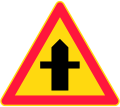 Junction with a road the users of which must give way, 90° left, 90° right
Junction with a road the users of which must give way, 90° left, 90° right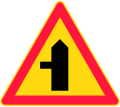 Junction with a road the users of which must give way, 90° left
Junction with a road the users of which must give way, 90° left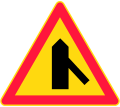 Junction with a road the users of which must give way, 45° right
Junction with a road the users of which must give way, 45° right Traffic signals
Traffic signals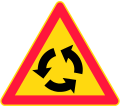 Roundabout warning
Roundabout warning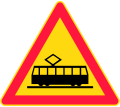 Tramway
Tramway Level crossing without gates
Level crossing without gates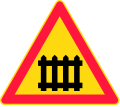 Level crossing with gates
Level crossing with gates Distance to level crossing
Distance to level crossing Single track level crossing
Single track level crossing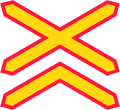 Multitrack level crossing
Multitrack level crossing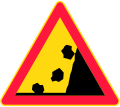 Falling rocks
Falling rocks Low-flying aircraft
Low-flying aircraft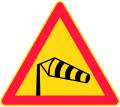 Crosswind
Crosswind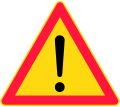 Other dangers
Other dangers
Priority signs
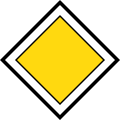 Priority road
Priority road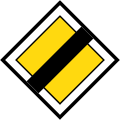 End of priority road
End of priority road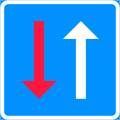 Priority over oncoming vehicles
Priority over oncoming vehicles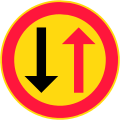 Priority for oncoming vehicles
Priority for oncoming vehicles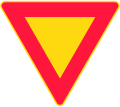 Give way
Give way Stop (and give way)
Stop (and give way)
Prohibitory signs
Prohibitory signs are round with yellow backgrounds and red borders, except the no parking and no standing signs that have a blue background instead of yellow.
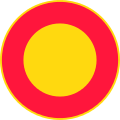 Closed to all vehicles in both directions
Closed to all vehicles in both directions No power-driven vehicles
No power-driven vehicles No lorries or vans
No lorries or vans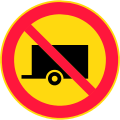 No combinations (of a vehicle and a trailer)
No combinations (of a vehicle and a trailer)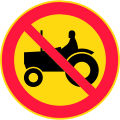 No tractors, construction vehicles etc.
No tractors, construction vehicles etc.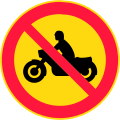 No motorcycles
No motorcycles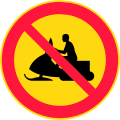 No off-road vehicles
No off-road vehicles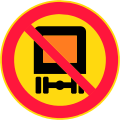 No vehicles carrying dangerous goods
No vehicles carrying dangerous goods No buses
No buses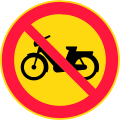 No mopeds
No mopeds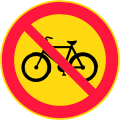 No cycles or mopeds
No cycles or mopeds No pedestrians
No pedestrians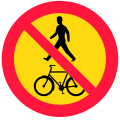 No pedestrians, cycles or mopeds
No pedestrians, cycles or mopeds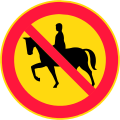 No riding
No riding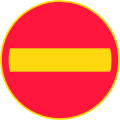 No entry
No entry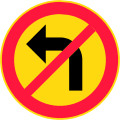 No left turn
No left turn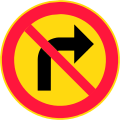 No right turn
No right turn No U-turns
No U-turns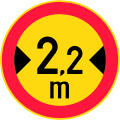 No vehicles having an overall width exceeding [...] meters
No vehicles having an overall width exceeding [...] meters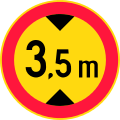 No vehicles having an overall height exceeding [...] meters
No vehicles having an overall height exceeding [...] meters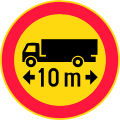 No vehicles or combination of vehicles exceeding [...] meters
No vehicles or combination of vehicles exceeding [...] meters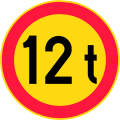 No vehicles exceeding [...] tonnes laden weight
No vehicles exceeding [...] tonnes laden weight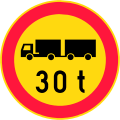 No vehicles or combination of vehicles exceeding [...] tonnes laden weight or bearing capacity class
No vehicles or combination of vehicles exceeding [...] tonnes laden weight or bearing capacity class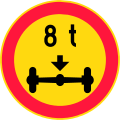 No vehicles having a weight exceeding [...] tonnes on one axle
No vehicles having a weight exceeding [...] tonnes on one axle No vehicles having a weight exceeding [...] tonnes on a tandem axle
No vehicles having a weight exceeding [...] tonnes on a tandem axle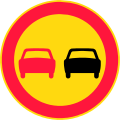 No overtaking
No overtaking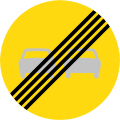 End of overtaking restriction
End of overtaking restriction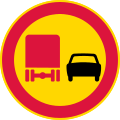 No overtaking by lorries
No overtaking by lorries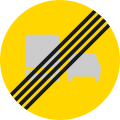 End of overtaking by lorries restriction
End of overtaking by lorries restriction.svg.png) Speed limit
Speed limit.svg.png) End of speed limit
End of speed limit.svg.png) Speed limit zone
Speed limit zone.svg.png) End of speed limit zone
End of speed limit zone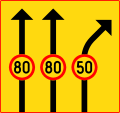 Prohibition or restriction applying to one or more traffic lanes
Prohibition or restriction applying to one or more traffic lanes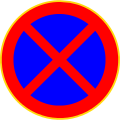 No standing or parking
No standing or parking No parking
No parking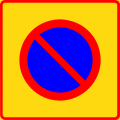 No parking zone
No parking zone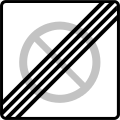 End of no parking zone
End of no parking zone Taxi station zone
Taxi station zone Taxies stopping place
Taxies stopping place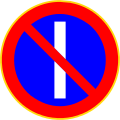 Alternative parking (prohibited on the odd days of month from 08:00 on that day until 08:00 on the next)
Alternative parking (prohibited on the odd days of month from 08:00 on that day until 08:00 on the next)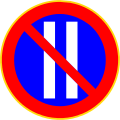 Alternative parking (prohibited on the even days of month from 08:00 on that day until 08:00 on the next)
Alternative parking (prohibited on the even days of month from 08:00 on that day until 08:00 on the next)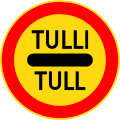 Passing without stopping prohibited (customs control)
Passing without stopping prohibited (customs control)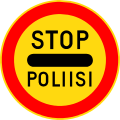 Passing without stopping prohibited (police control or other reason)
Passing without stopping prohibited (police control or other reason) Minimum distance between power driven vehicles
Minimum distance between power driven vehicles
Mandatory signs
Mandatory signs are always round blue signs with white border.
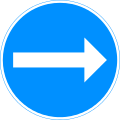 Direction to be followed. Right only
Direction to be followed. Right only Direction to be followed. Straight ahead only
Direction to be followed. Straight ahead only Direction to be followed. Turn right
Direction to be followed. Turn right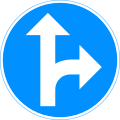 Direction to be followed. Turn right or continue straight ahead.
Direction to be followed. Turn right or continue straight ahead.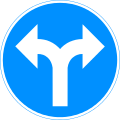 Direction to be followed. Turn left or right.
Direction to be followed. Turn left or right.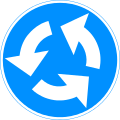 Compulsory roundabout
Compulsory roundabout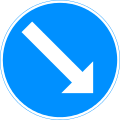 Pass this side
Pass this side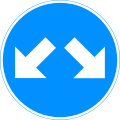 Pass this side. Either side
Pass this side. Either side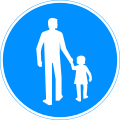 Footpath
Footpath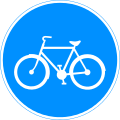 Cycleway
Cycleway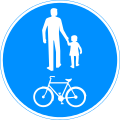 Compulsory track for pedestrians and cyclists
Compulsory track for pedestrians and cyclists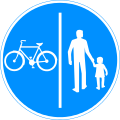 Compulsory track for pedestrians and cyclists. Dual track
Compulsory track for pedestrians and cyclists. Dual track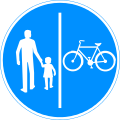 Compulsory track for pedestrians and cyclists. Dual track
Compulsory track for pedestrians and cyclists. Dual track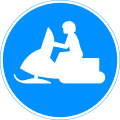 Track for off-road vehicles
Track for off-road vehicles Track for rider on horseback
Track for rider on horseback
Special regulation signs
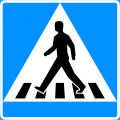 Pedestrian crossing
Pedestrian crossing Park and ride
Park and ride Park and ride
Park and ride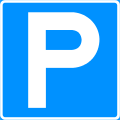 Parking
Parking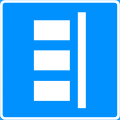 Placing vehicles on a parking place
Placing vehicles on a parking place Placing vehicles on a parking place
Placing vehicles on a parking place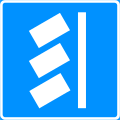 Placing vehicles on a parking place
Placing vehicles on a parking place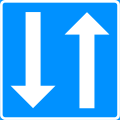 Passing place (on narrow roads)
Passing place (on narrow roads) Bus stop for local traffic
Bus stop for local traffic Bus stop for long-distance traffic
Bus stop for long-distance traffic Tramway stop
Tramway stop Taxi station
Taxi station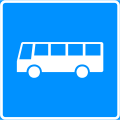 Bus lane (sign above the line)
Bus lane (sign above the line)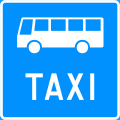 Bus and taxi lane (sign above the line)
Bus and taxi lane (sign above the line) End of bus lane (sign above the line)
End of bus lane (sign above the line)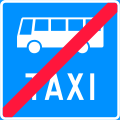 End of bus and taxi lane (sign above the line)
End of bus and taxi lane (sign above the line)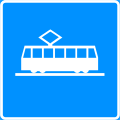 Tramway lane (sign above the line)
Tramway lane (sign above the line) Tramway and taxi lane (sign above the lane)
Tramway and taxi lane (sign above the lane)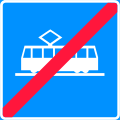 End of tramway lane (sign above the line)
End of tramway lane (sign above the line)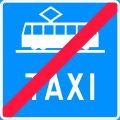 End of tramway and taxi lane (sign above the lane)
End of tramway and taxi lane (sign above the lane) One-way traffic
One-way traffic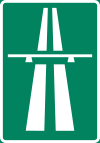 Motorway
Motorway End of motorway
End of motorway Road for motor vehicles
Road for motor vehicles End of road for motor vehicles
End of road for motor vehicles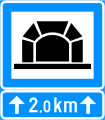 Tunnel
Tunnel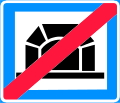 End of tunnel
End of tunnel Emergency stopping place
Emergency stopping place Built-up area
Built-up area End of built-up area
End of built-up area Residential area
Residential area End of residential area
End of residential area Pedestrian zone
Pedestrian zone End of pedestrian zone
End of pedestrian zone
Signs giving information
 Advance direction sign (type A)
Advance direction sign (type A) Advance direction sign (type B)
Advance direction sign (type B) Advisory sign for detour
Advisory sign for detour Advisory sign for detour
Advisory sign for detour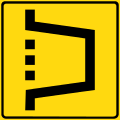 Detour
Detour Route to be followed (in order to turn left)
Route to be followed (in order to turn left)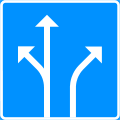 Information on traffic lanes
Information on traffic lanes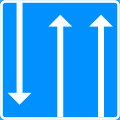 Information on traffic lanes
Information on traffic lanes End of lane
End of lane Advance direction sign (above the lane; type A)
Advance direction sign (above the lane; type A) Advance direction sign (above the lane; type B)
Advance direction sign (above the lane; type B) Exit sign (above the lane)
Exit sign (above the lane) Direction sign
Direction sign Exit sign
Exit sign Direction sign on private road
Direction sign on private road Location sign
Location sign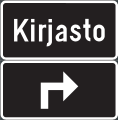 Advance location sign
Advance location sign Direction sign for light traffic (pedestrian and cycle traffic)
Direction sign for light traffic (pedestrian and cycle traffic) Direction sign for detour
Direction sign for detour Direction sign for detour
Direction sign for detour Direction sign for local purposes
Direction sign for local purposes Direction sign showing a motorway or road for motor vehicles
Direction sign showing a motorway or road for motor vehicles Direction sign showing park-and-ride facilities
Direction sign showing park-and-ride facilities No through road
No through road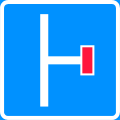 No through road
No through road.svg.png) Recommended maximum speed
Recommended maximum speed Sign showing distances
Sign showing distances Place name
Place name Road number (E-road; European route)
Road number (E-road; European route)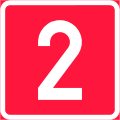 Road number (primary road; main road, Class I; 1–39)
Road number (primary road; main road, Class I; 1–39) Road number (secondary road; main road, Class II; 40–99)
Road number (secondary road; main road, Class II; 40–99) Road number (regional road; 100–999)
Road number (regional road; 100–999) Road number (ordinary road; connecting road; 1000–9999)
Road number (ordinary road; connecting road; 1000–9999) Direction to the numbered road
Direction to the numbered road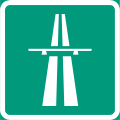 Symbol of motorway
Symbol of motorway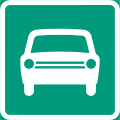 Symbol of road for motor vehicles
Symbol of road for motor vehicles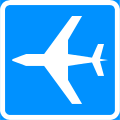 Airport
Airport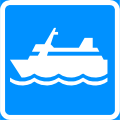 Ferry
Ferry Goods harbour
Goods harbour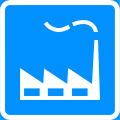 Industrial area
Industrial area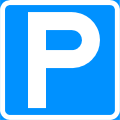 Parking
Parking Railway station
Railway station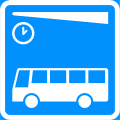 Bus station
Bus station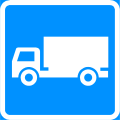 Itinerary for indicated vehicle category
Itinerary for indicated vehicle category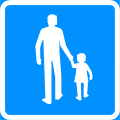 Itinerary for pedestrians
Itinerary for pedestrians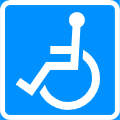 Itinerary for handicapped
Itinerary for handicapped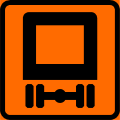 Itinerary for transport of dangerous goods
Itinerary for transport of dangerous goods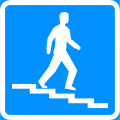 Overpass or underpass with steps
Overpass or underpass with steps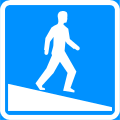 Overpass or underpass without steps
Overpass or underpass without steps Emergency exit
Emergency exit Direction to emergency exit
Direction to emergency exit
Service guide signs
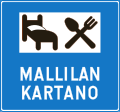 Information sign for services
Information sign for services Information sign for services
Information sign for services Advance information sign for services
Advance information sign for services Location sign for tourist service
Location sign for tourist service Advance location sign for tourist service
Advance location sign for tourist service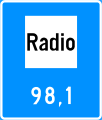 Radio station (frequency in MHz)
Radio station (frequency in MHz) Information point
Information point Information centre
Information centre First-aid
First-aid Breakdown service
Breakdown service Filling station
Filling station 723. Hotel or motel
723. Hotel or motel Restaurant
Restaurant Cafeteria or refreshments
Cafeteria or refreshments Public lavatory
Public lavatory Youth hostel
Youth hostel Camping site
Camping site Caravan site
Caravan site Picnic site
Picnic site Outing site
Outing site Tourist route
Tourist route Tourist route
Tourist route Museum or historic building
Museum or historic building
 Nature site
Nature site Viewpoint
Viewpoint Zoo
Zoo Other tourist attraction
Other tourist attraction Swimming place
Swimming place Fishing place
Fishing place Ski lift
Ski lift Golf course
Golf course Pleasure or theme park
Pleasure or theme park Cottage accommodation
Cottage accommodation Bed and breakfast
Bed and breakfast Direct sale
Direct sale Handicrafts
Handicrafts Farm park
Farm park Horseback riding
Horseback riding Emergency phone
Emergency phone Extinguisher
Extinguisher
Additional panels
 Sign applies to crossing road
Sign applies to crossing road Sign applies in the direction of the arrow
Sign applies in the direction of the arrow Sign applies [...] km in the direction of the arrow
Sign applies [...] km in the direction of the arrow Distance to which the sign applies
Distance to which the sign applies Distance from the sign to the point to which the sign applies
Distance from the sign to the point to which the sign applies Distance to the compulsory stop
Distance to the compulsory stop Free width
Free width Free height
Free height Height of electric line
Height of electric line Sign applies to both directions
Sign applies to both directions Sign applies to both directions
Sign applies to both directions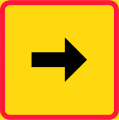 Sign applies in the direction of the arrow
Sign applies in the direction of the arrow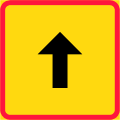 Regulation begins from the sign
Regulation begins from the sign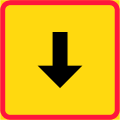 Regulation ends to the sign
Regulation ends to the sign Passenger car
Passenger car Bus
Bus Lorry
Lorry Vehicle combination
Vehicle combination Van
Van Caravan
Caravan Vehicle for handicapped
Vehicle for handicapped Motorcycle
Motorcycle Moped
Moped Cycle
Cycle Method of parking
Method of parking Method of parking
Method of parking No entry for vehicles carrying dangerous goods of group A
No entry for vehicles carrying dangerous goods of group A No drive-through for vehicles carrying dangerous goods of group B
No drive-through for vehicles carrying dangerous goods of group B Sign applies between 08.00 and 17.00 hours, Mo-Fr
Sign applies between 08.00 and 17.00 hours, Mo-Fr Sign applies between 08.00 and 13.00 hours, on Saturdays
Sign applies between 08.00 and 13.00 hours, on Saturdays Sign applies between 08.00 and 14.00 hours, on Sundays and holidays
Sign applies between 08.00 and 14.00 hours, on Sundays and holidays Time limit
Time limit Parking against fee
Parking against fee Parking against fee
Parking against fee Obligatory use of parking disc
Obligatory use of parking disc Obligatory use of parking disc
Obligatory use of parking disc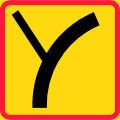 Direction of priority road
Direction of priority road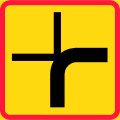 Direction of priority road
Direction of priority road Crossing of log transport road
Crossing of log transport road Two-way cycle track
Two-way cycle track Additional panel with text ”Occasionally foggy”
Additional panel with text ”Occasionally foggy” Additional panel with text ”Driving in service purposes allowed”
Additional panel with text ”Driving in service purposes allowed” Emergency telephone and extinguisher
Emergency telephone and extinguisher